A 3-way switch wiring diagram is a visual guide for controlling lights from two locations. It shows connections for power, load, and traveler wires, ensuring proper circuit functionality. Essential for DIYers and electricians, these diagrams simplify complex wiring scenarios, promoting safety and efficiency in installations. They are available in PDF formats for easy reference, covering various setups and configurations.
1.1 What is a 3-Way Switch?
A 3-way switch is an electrical device used to control a light fixture from two different locations. It features three terminals: one common (black) and two travelers (brass). These switches are designed to work in pairs, allowing seamless operation of a single light from multiple points. Unlike a standard 2-way switch, the 3-way switch does not have an “ON” or “OFF” position, as its state depends on the other switch in the circuit. This setup is ideal for staircases, hallways, or large rooms, ensuring efficient lighting control without the need for pull chains or additional wiring complexity.
1.2 Importance of Wiring Diagrams for 3-Way Switches
Wiring diagrams are crucial for installing 3-way switches correctly. They provide a clear visual representation of connections, ensuring that wires are linked properly between switches, lights, and power sources. These diagrams help prevent common mistakes, such as misconnecting traveler wires or forgetting the ground wire. They also guide DIYers and electricians through different scenarios, like powering through a switch or a light fixture. By following a wiring diagram, one can avoid safety hazards and ensure the system operates as intended. This makes diagrams indispensable for both novice and experienced individuals tackling 3-way switch installations.
1.3 Purpose of a 3-Way Switch Wiring Diagram PDF
A 3-way switch wiring diagram PDF serves as a comprehensive guide for installing and troubleshooting 3-way switches. It provides detailed visuals and instructions for various wiring configurations, such as controlling a light from two locations or integrating 4-way switches. The PDF format allows for easy access and printing, making it a portable resource for both professionals and DIY enthusiasts. By offering clear, step-by-step instructions and diagrams, it helps ensure safe and correct connections, reducing the risk of electrical hazards and system malfunctions. This resource is essential for anyone aiming to successfully wire a 3-way switch setup.
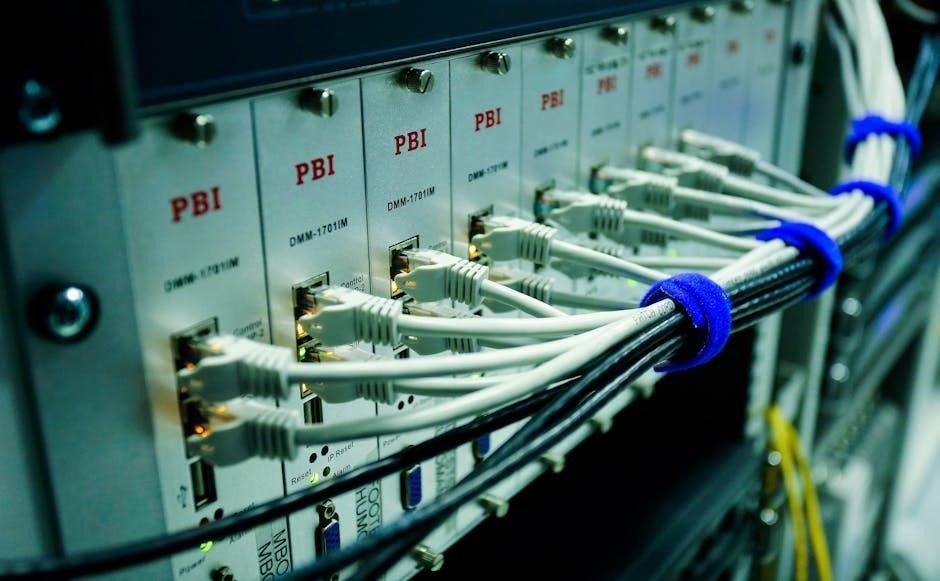
Understanding the Components of a 3-Way Switch
A 3-way switch includes key components like terminals for power, load, and traveler wires. It operates with three wires, enabling control of a light from two locations. The ground wire ensures safety, completing the circuit and preventing electrical hazards. Understanding these components is crucial for proper installation and functionality, as detailed in wiring diagrams.
2.1 Key Parts of a 3-Way Switch
A 3-way switch consists of three terminals: the common (COM) terminal and two traveler (L1 and L2) terminals. The common terminal connects to the power source or light fixture, while the travelers connect to the other switch. These terminals enable the switch to control a light from two locations. Additionally, a ground wire is present for safety, ensuring proper grounding and preventing electrical hazards. Understanding these components is essential for interpreting wiring diagrams and performing installations correctly. The design allows for efficient power routing and reliable operation in various configurations.
2.2 Types of Wires Used in 3-Way Switch Installations
In 3-way switch installations, several types of wires are used to ensure proper functionality. The hot (live) wire carries power from the source, while the neutral wire completes the circuit. Ground wires provide safety by grounding the system. Traveler wires connect the two 3-way switches, enabling communication between them. Typically, 14-gauge or 12-gauge wires are used for these connections. The wires are color-coded for identification: black for hot, white for neutral, and copper or green for ground; Using the correct wire types ensures safety and reliable performance in controlling lights from multiple locations. Proper wiring materials are essential for meeting electrical codes and standards.
2.3 Role of the Ground Wire in 3-Way Switch Wiring
The ground wire plays a critical role in 3-way switch wiring by providing a safe path for fault currents to the ground. It ensures electrical safety by preventing shocks and protecting equipment from damage. In systems with metal boxes, the ground wire connects to the box and switch, maintaining continuity. Proper grounding is essential for meeting electrical codes and preventing hazards. While older homes may lack a ground wire, modern installations require it for safety. Always connect the ground wire to the grounding terminal on the switch and to grounding wires in boxes to ensure a safe and reliable circuit.
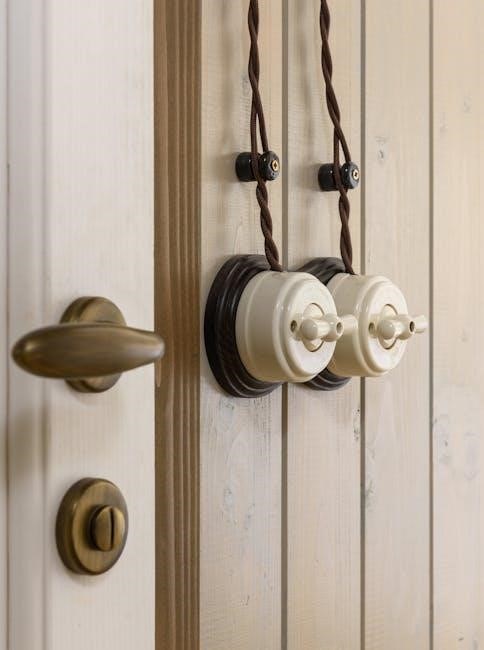
Basic Wiring Configurations for 3-Way Switches
Basic wiring configurations include power through a switch box, power through the light fixture, and wiring a light between two 3-way switches. These setups ensure proper circuit functionality and safety, with clear diagrams guiding connections for load, traveler, and ground wires.
3.1 Power Through a Switch Box
In this configuration, the power supply enters directly into one of the 3-way switches. The load wire connects from the switch to the light fixture, while the traveler wires connect between the two switches. This setup allows the light to be controlled from either switch location. The ground wire is connected to both switches and the fixture for safety. Proper wiring ensures the circuit functions correctly, with the light turning on and off from both switches. Diagrams illustrate how to connect the wires, emphasizing the importance of correct terminal usage to avoid short circuits and ensure reliable operation.
3.2 Power Through the Light Fixture
In this setup, the power supply enters the light fixture first, not the switch box. The hot wire connects to the fixture, and the switch legs are wired between the fixture and the 3-way switches. The traveler wires run between the two switches, allowing them to control the light. The ground wire is connected to the fixture and both switches for safety. This configuration ensures the light can be operated from either switch, with the fixture acting as the power distribution point. Wiring diagrams highlight this setup, emphasizing the importance of correct connections to maintain proper functionality and safety standards. Proper installation prevents electrical hazards and ensures reliable operation.
3.3 Wiring a Light Between Two 3-Way Switches
When wiring a light between two 3-way switches, the light fixture is installed between the switches. The hot wire from the power source connects to one of the switches. The traveler wires are connected between the two switches, allowing them to communicate. The common wires from each switch are connected to the light fixture’s brass terminals. The ground wire is connected to both switches and the fixture for safety. This setup ensures the light can be controlled from either switch. Wiring diagrams for this configuration are essential to avoid errors and ensure proper operation. Proper connections are critical to prevent electrical issues and ensure reliable control of the light from both locations.
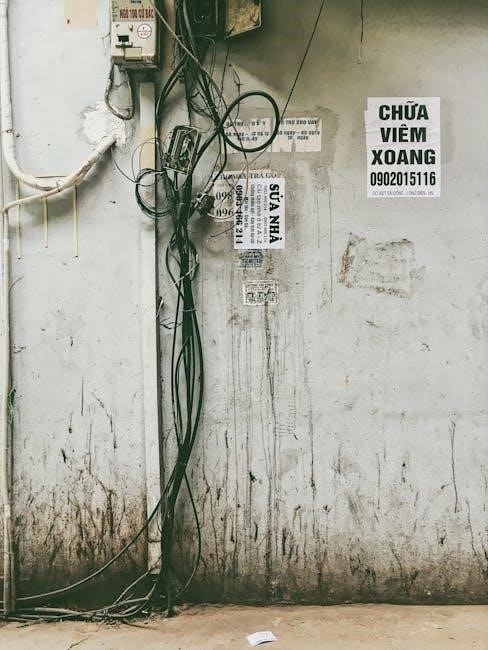
Advanced Wiring Scenarios
Explore complex setups, including controlling multiple lights, integrating 4-way switches, and adding smart dimmers. Learn safety tips and proper tools for reliable operation in advanced configurations.
4.1 Controlling Multiple Lights with 3-Way Switches
Controlling multiple lights with 3-way switches requires a structured wiring setup. Each switch controls the power supply to the lights, using traveler wires to connect the switches. The common wire connects to the lights, ensuring synchronized operation. This configuration allows seamless control of multiple fixtures from different locations. Proper wiring ensures reliability and safety. Always follow the wiring diagram for accurate connections and test the setup before finalizing. This method is ideal for large spaces or multi-level lighting systems, offering flexibility and convenience in lighting control.
4.2 Installing 3-Way Switches in Series
Installing 3-way switches in series involves connecting them in a linear configuration, where power flows through each switch sequentially. This setup allows multiple switches to control a single light fixture. The series wiring connects the line wire to the first switch, with traveler wires linking subsequent switches. Each switch acts as a control point, enabling operation from different locations. However, this configuration can lead to voltage drop and switch overload. Proper wiring and testing are essential to ensure safe and efficient operation. Always refer to a wiring diagram for accuracy and avoid power-through configurations in series setups.
4.3 Integrating 4-Way Switches with 3-Way Switches
Integrating 4-way switches with 3-way switches allows for more complex lighting control systems. A 4-way switch is installed between two 3-way switches, enabling control from three or more locations. The 4-way switch connects to the traveler wires of the 3-way switches, maintaining the circuit path. The common terminal on the 4-way switch ensures continuity when switches are in different positions. Proper wiring requires careful planning, and a wiring diagram is essential to avoid errors. This setup is ideal for larger spaces with multiple control points, providing flexibility and convenience in lighting operation.
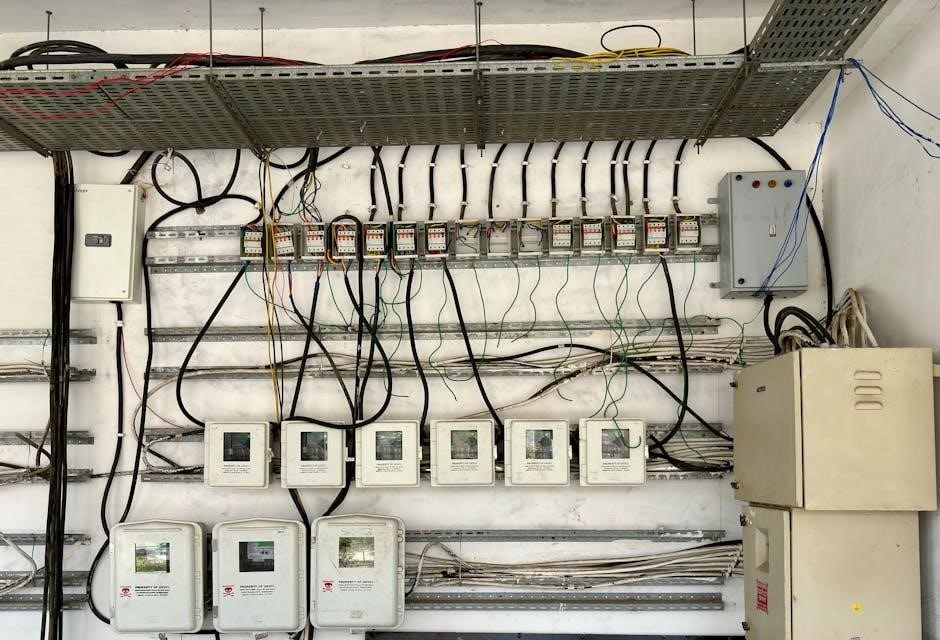
Safety Precautions and Best Practices
Always turn off power at the breaker before starting work. Use a voltage tester to ensure wires are de-energized. Wear insulated gloves and follow the wiring diagram precisely to avoid shocks or short circuits. Proper grounding is essential for safety, and all connections must be secure. Never skip steps or overlook warnings, as electrical mistakes can be dangerous. Keep tools and materials organized to maintain a safe working environment. Follow local electrical codes and best practices to ensure a safe and successful installation.
5.1 Essential Safety Tips for Wiring a 3-Way Switch
Before starting, always disconnect the power at the circuit breaker and verify wires are de-energized using a voltage tester. Wear insulated gloves and safety goggles to protect against electrical shocks. Ensure all connections are secure and tightly screwed to prevent short circuits. Follow the wiring diagram carefully to avoid misconnections. Never work in damp conditions or with damaged tools. Keep children and pets away from the work area; If unsure, consult a licensed electrician. Proper grounding is critical, so never bypass ground wires. Label wires clearly to maintain clarity and safety throughout the process. Always double-check your work before restoring power.
5.2 Common Mistakes to Avoid in 3-Way Switch Wiring
Common mistakes include misidentifying the line, load, and traveler wires, leading to incorrect connections. Improperly securing wires under screw terminals can cause loose connections and potential fires. Neglecting to follow the wiring diagram is a frequent error, resulting in switch malfunction. Forgetting to turn off power before starting work is dangerous and can cause electrical shocks. Mixing up the black and red wires is another mistake, as it disrupts the circuit. Always double-check connections and ensure wires are properly stripped and secured to avoid such issues. Correcting these errors requires patience and attention to detail to ensure safe and proper functionality.
5.3 Importance of Proper Grounding
Proper grounding is essential for safety and functionality in 3-way switch wiring. The ground wire protects against electrical shocks by providing a safe path for fault currents. It ensures the circuit breaker trips during a short circuit, preventing fires and hazards. Grounding also reduces noise interference and stabilizes voltage levels. In 3-way switch setups, the ground wire must be connected to both the switch and the light fixture. Neglecting proper grounding can lead to unsafe conditions and equipment damage. Always verify ground wire connections to ensure compliance with electrical codes and maintain a secure system.

Tools and Materials Required
Essential tools include a voltage tester, needle-nose pliers, screwdriver set, and wire strippers. Materials needed are 12/14-gauge wires, wire nuts, and connectors for secure connections.
6.1 List of Tools Needed for 3-Way Switch Installation
Installing a 3-way switch requires specific tools to ensure safety and accuracy. A voltage tester is essential to confirm wires are de-energized. Needle-nose pliers and screwdrivers (both flathead and Phillips) are necessary for wire handling and switch mounting. Wire strippers are needed to prepare wire ends for connections. Lineman’s pliers can help grip and twist wires securely. A utility knife is useful for cutting wire insulation, while a multimeter can verify circuit integrity. Additionally, a ladder or step stool may be required for access, and a non-contact voltage tester provides added safety. Always use insulated tools to prevent electrical shock.
6.2 Materials Necessary for a Successful Installation
For a successful 3-way switch installation, gather essential materials. A 3-way switch and compatible electrical boxes are fundamental. Use 14-gauge or 12-gauge copper wire for reliable connections. Wire nuts or connectors ensure secure wire joins. Grounding wires are crucial for safety. Mounting screws and wall anchors stabilize the switch. A wiring diagram PDF acts as a helpful guide. Additionally, plastic or metal switch plates enhance durability. Ensure all materials meet local electrical codes for compliance and safety. Proper materials guarantee a professional-grade installation and prevent future issues.
6.3 Choosing the Right Wire for Your Project

Selecting the correct wire is critical for a 3-way switch installation. Use 14-gauge or 12-gauge copper wire for most residential setups, as they handle standard electrical currents effectively. Insulated wires, such as Romex cables, are ideal for dry locations, while THHN wires suit more demanding environments. Ensure wires are rated for the circuit’s voltage and amperage. Stranded wire offers flexibility, while solid-core wire is sturdier. Always include a grounding wire for safety. Refer to your wiring diagram PDF to confirm wire specifications for your specific setup. Proper wire selection ensures reliability and adherence to safety standards.
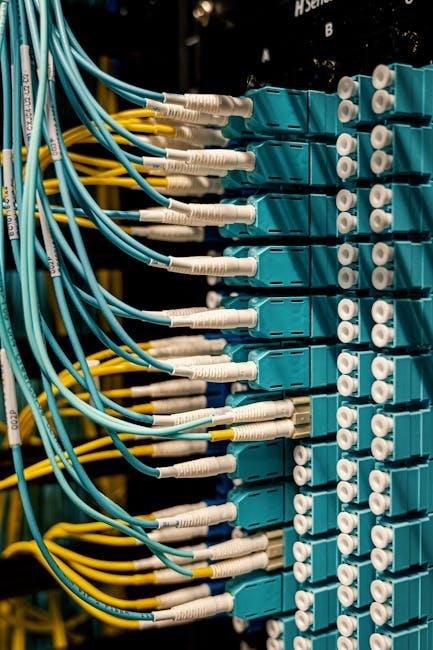
Step-by-Step Wiring Guide
Always refer to your wiring diagram PDF for precise instructions. Turn off power, prepare wires, and connect switches methodically. Test connections to ensure proper functionality.
7;1 Preparing the Wiring Components
Start by gathering all necessary tools and materials. Turn off the power supply at the circuit breaker. Inspect wires for damage and strip insulation as needed. Identify the black (hot), white (neutral), and copper (ground) wires. Use a voltage tester to confirm no electricity is present. Organize the wires and components neatly to avoid confusion. Refer to your 3-way switch wiring diagram PDF for specific wire color coding and connections. Ensure all terminals on switches and fixtures are clean and secure. This preparation ensures a smooth and safe installation process, minimizing errors during wiring. Always follow safety guidelines.
7.2 Connecting Wires to the 3-Way Switch
Locate the terminal screws on the 3-way switch. Identify the traveler wires, which connect between the two switches, and the common wire. Attach the traveler wires to the brass terminals and the common wire to the black terminal. Ensure the ground wire is securely connected to the grounding terminal. Use needle-nose pliers for precise connections. Double-check the wiring diagram PDF to confirm the correct configuration. Tighten all screws firmly to prevent loose connections. Avoid mixing up the traveler and common wires, as this can disrupt proper switch operation. Proper wire placement ensures reliable control of the light fixture from both switches.
7.3 Finalizing the Connections
Once all wires are securely attached to the switch, verify the connections against the wiring diagram PDF to ensure accuracy. Tighten all terminal screws firmly to prevent loose connections. Use wire nuts or connectors for any spliced wires, ensuring they are snug and not loose. Tuck the wires neatly into the switch box to avoid overcrowding. Restore power to the circuit and test the switches to confirm proper operation. If the lights function correctly, the installation is complete. If issues arise, consult the diagram or seek professional assistance to troubleshoot.

Troubleshooting Common Issues
Troubleshooting common issues involves identifying faulty connections, incorrect wiring, or switch failures. Refer to the wiring diagram PDF for guidance on resolving these problems effectively.
8.1 Identifying and Fixing Faulty Connections
Identifying faulty connections is crucial for ensuring proper 3-way switch operation. Start by examining the wiring diagram PDF to locate potential issue areas. Common signs include flickering lights or switches that fail to function. Check for loose wire connections and verify that all terminals are securely fastened. If a connection appears damaged, replace the wire or connector. Use a multimeter to test for continuity and ensure the wiring matches the diagram. Correcting these issues promptly prevents further complications and ensures safe, reliable operation of your lighting system.
8.2 Resolving Issues with Light Operation
When lights malfunction in a 3-way switch setup, start by consulting the wiring diagram PDF to verify connections. Ensure the light fixture is properly connected between the switches. Check for power at the fixture using a multimeter. If the light flickers, inspect for loose wires or incorrect color coding. Verify that the travelers are connected to the correct terminals. Ensure the common wire is linked properly to the light. If issues persist, test the switches for functionality and replace any faulty components. Always turn off power before troubleshooting to ensure safety.
8.3 Diagnosing and Repairing Ground Wire Problems
Ground wire issues can cause safety hazards and disrupt 3-way switch functionality. Start by ensuring the ground wire is securely connected to both switches and the light fixture. Use a multimeter to test continuity between the ground wire and a known grounding point. If the ground wire is damaged, replace it immediately. Verify that all connections are tight and free from corrosion. Consult the wiring diagram PDF to confirm proper grounding paths. Always turn off power at the circuit breaker before working on the system to ensure your safety while diagnosing and repairing ground wire faults.

Variations in Wiring Diagrams
Wiring diagrams vary based on materials, construction types, and smart home integration, requiring tailored approaches for different setups and technologies.
9.1 Differences in Plastic vs. Metal Boxes
Plastic and metal boxes have distinct features that affect 3-way switch wiring. Plastic boxes are lightweight, non-conductive, and ideal for residential use, offering ease of installation without grounding concerns. Metal boxes, while more durable and suitable for commercial settings, require grounding to ensure safety and proper electrical flow. This distinction influences wiring diagrams, as metal boxes necessitate grounding wire connections, which are typically absent in plastic boxes. Understanding these differences is crucial for accurate and safe wiring configurations in various environments.
9.2 Wiring in Older Homes vs. New Constructions
Wiring in older homes differs significantly from new constructions, impacting 3-way switch installations. Older homes often have outdated systems, such as knob-and-tube wiring, which may lack grounding and require additional safety measures. New constructions, however, adhere to modern codes with grounded systems, making installations more straightforward. Differences in wire insulation, circuit design, and electrical box types also play a role. Understanding these variations is essential for safe and compatible wiring, as older systems may need retrofitting to support modern 3-way switch configurations effectively.
9.3 Special Considerations for Smart Home Integration
Integrating 3-way switches into smart home systems requires careful consideration of compatibility and additional wiring needs. Smart switches often need a neutral wire for power, which may not be present in older systems. Configuration involves pairing switches with a smart hub, possibly requiring a stable internet connection and specific apps. Hardwired or wireless options affect the wiring diagram, and power requirements must be checked. Ensure compatibility and consult professionals if unsure. Benefits include remote control, voice command via smart assistants, and energy monitoring for optimized performance and convenience.
Mastering 3-way switch wiring enhances home lighting control and safety. Use diagrams and resources for guidance, ensuring installations meet local codes and standards for reliability.
10.1 Summary of Key Points
Understanding 3-way switch wiring is crucial for controlling lights from multiple locations. Always use a wiring diagram to ensure proper connections. The common wire connects to the light, while traveler wires link switches. Ground wires are essential for safety. Verify power is off before starting work. Use a voltage tester to confirm. Double-check connections to avoid short circuits. If unsure, consult a licensed electrician. Proper wiring ensures reliable performance and safety. Follow local electrical codes and best practices for a successful installation.
10.2 Where to Find Additional Information
For comprehensive understanding of 3-way switch wiring diagrams, explore reputable resources like The Spruce or This Old House. These websites often provide detailed guides and diagrams specifically for controlling lights from multiple locations. Additionally, check official guides or downloadable PDFs from electrical supply companies, which may offer clear wiring diagrams. Consider visiting forums or communities such as Reddit or DIY forums, where experts and enthusiasts share knowledge and resources. YouTube tutorials can also offer visual explanations for clearer understanding. For in-depth information, consult books or e-books on home electrical wiring, available at libraries or online. Tool manufacturer websites like Klein Tools or Fluke may provide educational resources. Lastly, hardware stores like Home Depot or Lowe’s often have resource sections on their websites with wiring instructions and diagrams. Ensure all sources are reliable and up-to-date for safety and accuracy. By exploring these avenues, you can gather the necessary information to confidently wire a 3-way switch.
10.3 Recommended Tools and Resources for Further Learning
For mastering 3-way switch wiring, essential tools include wire strippers, a multimeter, and a voltage tester. Pliers and screwdrivers are also crucial for secure connections. For resources, consider downloading detailed 3-way switch wiring diagram PDFs from trusted electrical websites. Platforms like YouTube offer step-by-step video guides, while forums like Reddit’s DIY community provide hands-on advice. Additionally, books such as Wiring Complete by Black & Decker offer comprehensive guidance. Manufacturer websites like Leviton or Lutron often provide installation manuals and troubleshooting tips. These tools and resources will enhance your understanding and ensure safe, successful projects.
